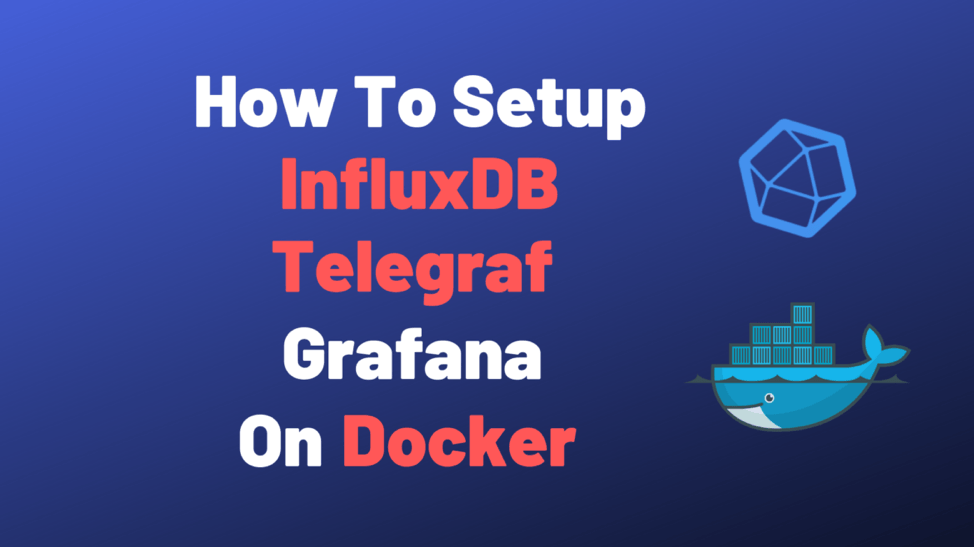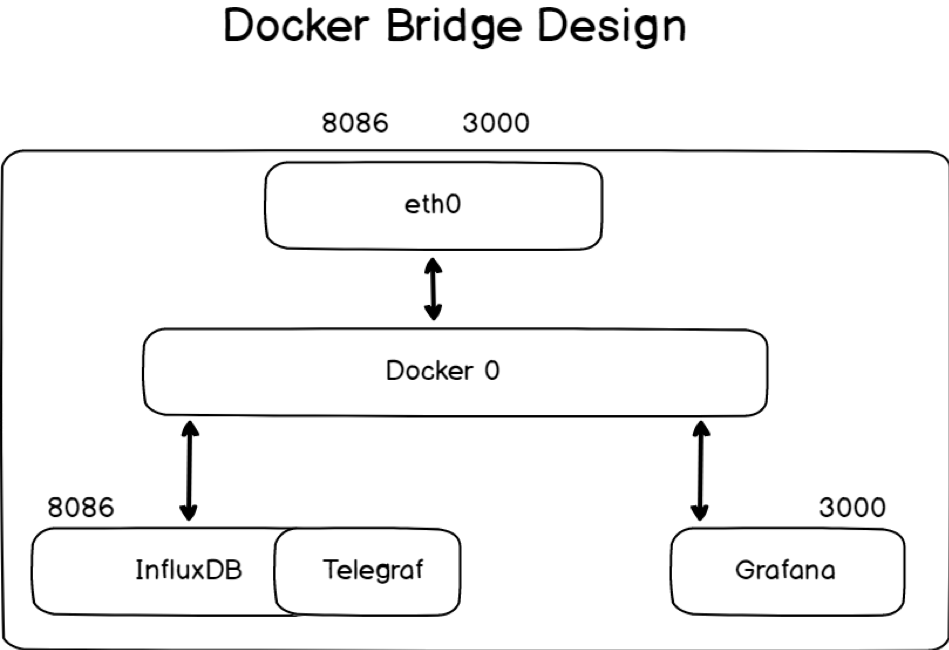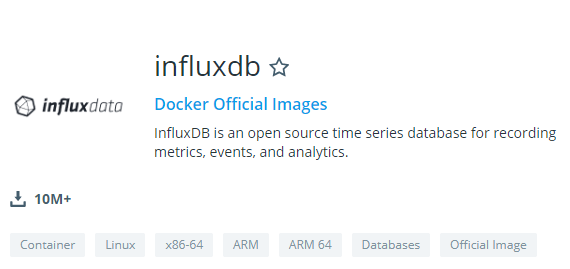How to Setup InfluxDB, Telegraf and Grafana on Docker: Part 1
By
Community /
Product, Use Cases
Nov 11, 2019
Navigate to:
This post was written by InfluxAce Antoine Solnichkin.

Built in 2013 by InfluxData, InfluxDB is by far one of the most-used time series databases for DevOps monitoring and dashboarding. Used by many successful companies worldwide, InfluxDB is often deployed in distributed and often multicloud. Docker can serve as a good fit for many organizations as a virtualization environment that provides an easy way to create, manage and delete containers on the fly. If you are trying to build reliable monitoring architectures, one solution would be to install InfluxDB on Docker and to manage it with Kubernetes.
In Part 1 of this tutorial series, we cover the steps to install InfluxDB 1.7 on Docker for Linux instances. Then later, we will describe in Part 2 how to install the Telegraf plugin for data-collection and the Grafana interface with InfluxDB 1.7 and Docker. To note, InfluxDB will soon become InfluxDB 2.0, which will serve as a a single platform to manage all the components of the TICK Stack. Another tutorial about how to install and set up for InfluxDB 2.0 is coming soon. Before you begin, it is important to ensure that all the prerequisites are met to install InfluxDB on Docker.
Prerequisites
Sudo privileges
First of all, you need to have sudo rights on your Linux machine; otherwise, you won’t be able to install InfluxDB on your host.
To verify it, run the following command:
$ sudo -vIf no error messages are shown on your terminal, you are good to go.
Next, you want to make sure that Docker is correctly installed on your system.
Docker correctly installed and configured
The tutorial “How To Install Docker on Ubuntu 18.04 and Debian 10” offers thorough details on how to correctly set up Docker on Linux. Once again to verify that Docker is correctly installed, you can run the following command:
$ docker --version Docker version 19.03.1, build 74b1e89Now that Docker is ready, let’s have a quick look at the networking strategy we are going to use for our containers.
Designing the network strategy for InfluxDB
Before you begin, it is important to review a few details about networking. By default, newly created containers run on the bridge network stack. In addition, after you install InfluxDB, it will be exposed to useful ports (such as port 8086) on your network stack. Later, you can also bind Telegraf to it, but Telegraf does not have to expose any ports to your current host stack.
Let’s run InfluxDB on the default bridge network, and have Telegraf running in the same stack as InfluxDB. In addition, we will add Grafana to our bridge network in order to visualize metrics gathered by Telegraf.

Now that we have seen the network strategy we are going to use, let’s install the InfluxDB container for Docker.
To install InfluxDB on Docker, you have two ways of doing it.
You can prepare your filesystem manually, and run the InfluxDB on a Docker container with no initialization scripts. This is the simplest way to initialize InfluxDB. This method should be used if you plan on running InfluxDB on a single instance, and if your initial InfluxDB configuration is very simple, or if you prefer to have full control over your containers.
However, there is a way to initialize InfluxDB with scripts (either bash scripts, or InfluxQL scripts). You should do this if you are automating a lot of servers with InfluxDB (with Chef or Puppet for example), and you want to have the same initial setup on all your instances.
Installing InfluxDB 1.7.x on Docker
The official InfluxDB image for Docker is called influxdb.

This InfluxDB image is part of the Official Docker Images, so you can rest assured that you are running an official version of InfluxDB on your system. Moreover, the other tools of the TICK Stack (Telegraf, InfluxDB, Chronograf and Kapacitor) are also a part of the Official Docker Images.
The InfluxDB image will install the InfluxDB server responsible for storing time-series metrics on your system.
If you are familiar with Docker, you already know that you can map volumes from your local filesystem to your container in order to manipulate data easier in your container. This is exactly what we are going to do in this tutorial.
Configuration files, as well as directories storing actual data, will be stored on our local filesystem.
Prepare InfluxDB 1.7.x for Docker
If you carefully follow the tutorial on setting up InfluxDB on Ubuntu, you know that you are going to create a specific user for your InfluxDB database.
$ sudo useradd -rs /bin/false influxdbIn your etc directory, create a new folder for your InfluxDB configuration files.
$ sudo mkdir -p /etc/influxdbCreating a configuration file for InfluxDB and Docker
Luckily, you don’t have to create an InfluxDB configuration file by yourself. To create an InfluxDB configuration file using Docker, run the following command:
docker run --rm influxdb influxd config | sudo tee /etc/influxdb/influxdb.conf > /dev/nullAs a quick explanation, the influxd config command will print a full InfluxDB configuration file for you on the standard output (which is by default your shell).
As the –rm option is set, Docker will run a container in order to execute this command and the container will be deleted as soon as it exits. Instead of having the configuration file printed on the standard output, it will be redirected to our InfluxDB configuration file.
Next, reassign the folder permissions for your newly created file; otherwise, your container won’t be able to interact with it properly.
$ sudo chown influxdb:influxdb /etc/influxdb/
Creating a lib folder for InfluxDB and Docker
As stated in the documentation, InfluxDB stores its data, metadata as well as the WAL (for write-ahead log) in the /var/lib/influxdb folder by default.
As a consequence, you have to create this folder if it does not currently exist.
$ sudo mkdir -p /var/lib/influxdbAgain, make sure that the permissions are correctly set for your container to write into this folder.
$ sudo chown influxdb:influxdb /var/lib/influxdb
Now that our folders are ready, let’s see how we can initialize InfluxDB with custom scripts.
Preparing initialization scripts for InfluxDB on Docker (optional)
With the InfluxDB image, there is a way to automate the database initialization on your containers. As an example, we will instruct our Docker container to create an administrator account, a regular user account (for Telegraf), and a database with custom retention via a custom InfluxQL script.
Anatomy of the InfluxDB image
On container boot, the entrypoint.sh script is executed, it is set as the entrypoint of your Docker container.
The entrypoint can be executed in two ways.
You can execute the entrypoint script in order to launch a simple InfluxDB instance on your container. This is for example what we have done in the previous section. We specified the configuration flag, and it was used in order to set your InfluxDB server initialization.
However, there is a second way to execute the entrypoint script: by executing the init-influxdb script.
The init-influxdb script is made of two parts:
- First, it will watch for environment variables passed to your docker command, and it will execute commands accordingly.
- Next, if you have a docker-entrypoint-initdb.d directory at the root directory of your container, it will execute either bash scripts or IQL scripts in it.
We are going to use this information to create our InfluxDB container.
First, make sure that no folders are already created in your /var/lib/influxdb folder.
$ ls -l /var/lib/influxdb
total 0Execute the following command for the meta folder (in the influxdb folder) to be updated with the correct information. As a reminder, we want an admin account and a regular account for Telegraf (named telegraf).
Creating initialization scripts on your host
In order for the initialization scripts to run on initialization, they have to be mapped to the docker-entrypoint-initdb.d folder in your container.
First, create a scripts folder on your host wherever you want. In my case, it is going to be created in /etc/influxdb.
$ sudo mkdir -p /etc/influxdb/scriptsEdit a new script file on your newly created folder, and make sure to give it a .iql extension:
$ sudo touch influxdb-init.iqlCREATE DATABASE weather;
CREATE RETENTION POLICY one_week ON weather DURATION 168h REPLICATION 1 DEFAULT;This a simple initialization script that will create a database for weather data, and it will assign a one-week retention policy for the database.
Great!
The last step will be to prepare our meta folder for InfluxDB initialization.
Creating/updating the InfluxDB meta database
In order to update your meta database, run the following command:
$ docker run --rm -e INFLUXDB_HTTP_AUTH_ENABLED=true \
-e INFLUXDB_ADMIN_USER=admin \
-e INFLUXDB_ADMIN_PASSWORD=admin123 \
-v /var/lib/influxdb:/var/lib/influxdb \
-v /etc/influxdb/scripts:/docker-entrypoint-initdb.d \
influxdb /init-influxdb.shNote: Setting the INFLUXDB_HTTP_AUTH_ENABLED to true does not mean that authentication is enabled on your InfluxDB server. Authentication is enabled in one of the next sections; this parameter is only used for the initialization script.
Please make sure that you have a couple of logs printed to your terminal. If this is not the case, make sure that you specified the correct environment variables for your container.

If you chose to create initialization scripts for your container, you should also have a log line for it.

As a last verification step, you can inspect your meta.db file in your meta folder to make sure that the changes were correctly written.
$ cat /var/lib/influxdb/meta/meta.db | grep one_week
Now that your InfluxDB files are prepared, let’s head over to some configuration verifications.
Verifying your InfluxDB configuration for Docker
If you used the configuration command detailed in the section above, you should be presented with a simple configuration file in the /etc/influxdb folder. Open your file and verify that everything is correct.
HTTP Interface
Head over to the [http] section of your configuration and make sure that it is enabled.
Verify that the bind address is set to 8086 by default. This is the port that you are going to use to send some commands to your InfluxDB database, like creating a database or adding a user for example.
By default, authentication and encryption are disabled. However, sections of this tutorial explain how you can set up authentication in depth.
Data, meta and WAL configurations
By default, your configuration file should have the paths that we created in the first section, so you don’t have to change anything. However, you should check that your paths are correct.
[meta]
dir = "/var/lib/influxdb/meta"
[data]
dir = "/var/lib/influxdb/data"
wal-dir = "/var/lib/influxdb/wal"Running the InfluxDB container on Docker
We are going to use the InfluxDB image from the official Docker repositories. As a quick reminder, you need to use the docker container run command in order to start a Docker container.
First, make sure that nothing is running on the port 8086.
$ sudo netstat -tulpn | grep 8086If you remember correctly, we configured our folders to be accessible by the InfluxDB user (belonging in the InfluxDB group). As a consequence, we will need the user ID of the InfluxDB user in order to run our container.
To find the InfluxDB user ID, head over to the passwd file on your host and run
$ cat /etc/passwd | grep influxdb
influxdb:x:997:997::/var/lib/influxdb:/bin/falseAs you can see, the user ID for my InfluxDB user is 997.
Note: the user ID will surely be different on your system, and you should modify it accordingly when running the docker command.
To start InfluxDB on Docker, run the following command.
docker run -d -p 8086:8086 --user 997:997 --name=influxdb \
-v /etc/influxdb/influxdb.conf:/etc/influxdb/influxdb.conf \
-v /var/lib/influxdb:/var/lib/influxdb \
influxdb \
-config /etc/influxdb/influxdb.confTesting your InfluxDB container
In order to test if your InfluxDB container is correctly running, you can check that the HTTP API is correctly enabled.
$ curl -G http://localhost:8086/query --data-urlencode "q=SHOW DATABASES"
You can also check that your InfluxDB server is correctly listening on port 8086 on your host.
$ netstat -tulpn | grep 8086
tcp6 0 0 :::8086 :::* LISTEN -Awesome! Your InfluxDB container is correctly running on Docker.
By default, your InfluxDB server does not contain any databases except for the _internal used, as its name describes, internal metrics about InfluxDB itself. However, if you created initialization scripts for your InfluxDB
database, make sure that your databases and retention policies are correctly assigned.
$ influx
Connected to http://localhost:8086 version 1.7.8
InfluxDB shell version: 1.7.7> SHOW USERS
user admin
---- -----
admin true
> SHOW DATABASES
name: databases
name
----
weatherEnabling authentication on InfluxDB for Docker
In order to enable authentication for InfluxDB 1.7.x, you are going to create an administrator account for your InfluxDB database (if you didn’t use initialization scripts)
Create an administrator account with docker exec
You don’t have to create an administrator account if you initialized your InfluxDB image with environment variables in the previous sections.
This is only necessary is you choose a fully customized InfluxDB image that you configure yourself.
To create an administrator account, connect to a bash process in your container and run the influx utility by yourself.
To achieve that, run the following commands
$ docker container ls
Note: If your container is not appearing here, then run this command with the -a (for all) flag to make sure that your container hasn’t crashed.
Identify the container ID of your InfluxDB container, and run the following command to have a bash in your container:
$ docker exec -it <container_id> /bin/bashAs a reminder, the docker exec is used in order to run a command in a running container.
Here are the options specified with it:
- -i : for interactive, it will keep the standard input open even if not attached
- -t : to allocate a pseudo-TTY to your current shell environment.
Right now, you should have a shell prompt, similar to this:

In your container, run the influx utility to create your administrator account.
$ influx
Connected to http://localhost:8086 version 1.7.8
InfluxDB shell version: 1.7.8> CREATE USER admin WITH PASSWORD 'admin123' WITH ALL PRIVILEGES
> SHOW USERS
user admin
---- -----
admin trueNow that you have an administrator account, you can enable the HTTP authentication for your database.
Enable HTTP authentication in your configuration file
To achieve that, exit your container, and head to the configuration folder you created for InfluxDB.
Ctrl + D (to exit your container)
$ sudo nano /etc/influxdb/influxdb.conf[http]
enabled = true
bind-address = ":8086"
auth-enabled = trueSave your file and restart your container for the changes to be applied.
$ docker container restart <container_id>To make sure that your changes are effective, try querying the HTTP API again.
You should be unable to execute a query without specifying the correct credentials.
$ curl -G http://localhost:8086/query --data-urlencode "q=SHOW DATABASES"
{"error":"unable to parse authentication credentials"}Great! Authentication is correctly enabled.
Let’s try to execute the InfluxQL query again with correct credentials.
$ curl -G -u admin:admin123 http://localhost:8086/query --data-urlencode "q=SHOW DATABASES"
{"results":[{"statement_id":0,"series":[{"name":"databases","columns":["name"],"values":[["_internal"]]}]}]}With this curl command, we made sure that our credentials were correctly set up for our InfluxDB server.
Now that your time series database is up and running, it is time to install our metrics collection agent: Telegraf.
